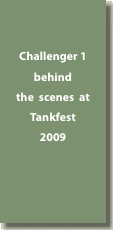
The Challenger replaced the Chieftain in the early 1980s. It came about as a result of a series of unconnected events across the world.
The roots of the vehicle go back to an order from Iran in 1974 for a number of modified and upgraded Chieftains, named the Shir, of which there were two variants planned. The former (Shir 1) was an upgraded Chieftain, and the other (Shir 2) was for a more modified version. Modifications for the Shir 2 were principally made to the weak points of the Chieftain; the engine and suspension. The Leyland engine was replaced by a Perkins diesel and the suspension (Horstmann bogie) was given a longer travel to improve cross-country performance. With hindsight, this can be seen as the Challenger 1 running gear.
In a roughly parallel move, the British Army was seeking to develop a Chieftain replacement utilising the new composite, Chobham, armour, as well as upgrades to the rest of the Chieftain systems. The project was known as the MBT 80 and was pitched against the US M1 Abrams and the German Leopard II. When it became clear that the armour would not be ready in time, this project was cancelled and the quest was on for a replacement.
In 1979, following the Iranian revolution and the departure of the Shah, the Shir order was cancelled. Thankfully for Vickers and the British government, the Jordanians stepped into the gap and took over the order for the Shir 1 which they subsequently named Khalid 1. The British also spotted the as yet undelivered Shir 2. The obvious political and commercial appeal of a home-grown successor to the Chieftain meant that it became the new MBT, Challenger. Although accepted in late 1982, it was as an interim solution and conditional upon the successful addressing of a series of issues around the sights, generator drives and other equipment. Between 1983 and 1990, around 420 were delivered.
Compared to its predecessor, the Challenger 1 was a major improvement. Its new engine was much more powerful and much more reliable. The Hydragas suspension featured a long wheel travel, resulting in a far better crew ride than that of the old Horstmann type of the Chieftain (and the Conqueror before that). The desirability of this feature had been known since the days of the Christie suspension of the 1930s (see T34) but achieving a solution to the perceived penalties had meant that the British tendency was to remain with other systems.
‘Stop-gap’ (as Challenger 1 might be regarded) or not, it went on to acquit itself well in service. During the First Gulf War in 1900-91, when British Challengers destroyed over 300 Iraqi AFVs without loss.
Aside from the British Army, the only other nation to operate the Challenger 1 has been Jordan.

